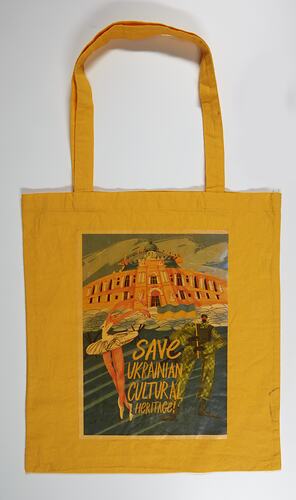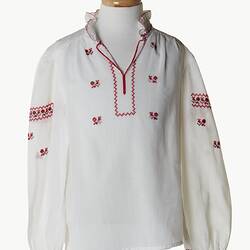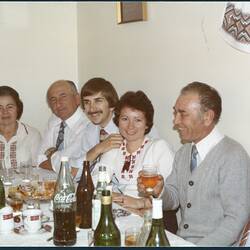Summary
Bag, yellow cotton, made by Natalie Senjov-Makohon, circa 2022. She has imprinted an image of the iconic opera house in Odessa created by Olga Rodznik, an artist in Odessa who gave unlimited use by the global Ukrainian community to raise awareness of the war in Ukraine and risk to Ukrainian cultural heritage. The opera house is set in a sea of sand bags and hedgehogs, and conveys the role of cultural workers playing their part in the efforts to save Ukrainian heritage, where dancers have volunteered to fight for their country and set designers in the streets weilding anti-tank sculptures. The image is inscribed: 'Save Ukrainian Cultural Heritage!' Natalie has produced a number of these bags as gifts for family and friends.
This item is part of a collection of textiles, cultural objects and photographs relating to the migration and settlement experiences of Katerina Senjov, and her daughter Natalie Senjov-Makohon who inherited her mother's passion for maintaining her Ukrainian cultural heritage.
Katerina Senjov (nee Burlak) and her husband Peter migrated to Melbourne from what is now Bosnia-Herzegovnia in 1954. Despite growing up in Bosnia, the Senjov and Burlak families always culturally identified as Ukrainian and spoke Ukrainian language.
They settled first in Geelong and then in Ascot Vale, had two children Natalie and Steven, whom they encoraged to learn traditional Ukrainian culture and traditions. The Senjovs actively participated in the Ukrainian community (including choirs, dance groups and gatherings wearing traditional regional clothing usually made by Katerina or her daughter Natalie).
The mother and daughter produced, wore, used, purchased and received, a range of Ukrainian cultural items including embroidered domestic and religious textiles, Ukrainian textile design publications, Pysanky (hand-painted eggs), a Bandura (stringed musical instrument) and timber inlay artworks.
Physical Description
Yellow cotton bag with two cotton shoulder straps, with image of a building, ballet dancer and text.
Significance
This collection provides a significant representation of traditional Ukrainian life and cultural practices subsequently transported to Australia through migration, and retained as part of the preservation, maintenance and adaptation of cultural life. In this family there was a strong and active passing down of cultural traditions, particularly down the female line.
The Museum holds a range of regional costumes, or costume components, from Sardinia, Latvia, Estonia, Poland, South Africa, Albania, Scotland, Greece, Hungary, Slovenia and Argentina; this collection relating to Ukraine further strengthens and expands the cultural representation of the collection. This material has been worn and used, is well provenanced, and has accompanying photographic documentation. This collection is also an important addition to the currently small collection relating to Ukrainian migration and settlement experiences.
The collection also includes domestic and religious Ukrainian embroidery and weaving, books documenting traditional Ukrainian designs used as references by the makers in Australia, Pysanky (painted eggs) in the tradition of many eastern European countries including Ukraine, and a Bandura (Ukrainian traditional musical instrument).
These items were all of importance in the expression of identity and place, some in the country of origin, and all in the place of re-settlement. Some of the costume pieces have played a role in the activities of community organisations in Australia; like similar associations, maintaining cultural practices and customs is increasingly challenging as subsequent generations become further distanced from the original migrant generation and through the natural process of community settlement, integration and assimilation within the context of a multiculturally diverse society.
More Information
-
Collection Names
-
Collecting Areas
Migration & Cultural Diversity, Clothing & Textiles, Home & Community, Leisure
-
Maker
-
Inscriptions
'Save Ukrainian Cultural Heritage!'
-
Classification
Cultural identity, Ethnicity - creative practice, Mixed media
-
Category
-
Discipline
-
Type of item
-
Object Dimensions
660 mm (Length), 360 mm (Width)
Includes shoulder straps
-
Keywords
Ukrainian Immigration, Folk Festivals, Needlework, Handcrafts, Cultural Traditions, Embroidery, Weaving, Sewing, Cultural Identity, Artworks, Crafts, Bags, Activism


